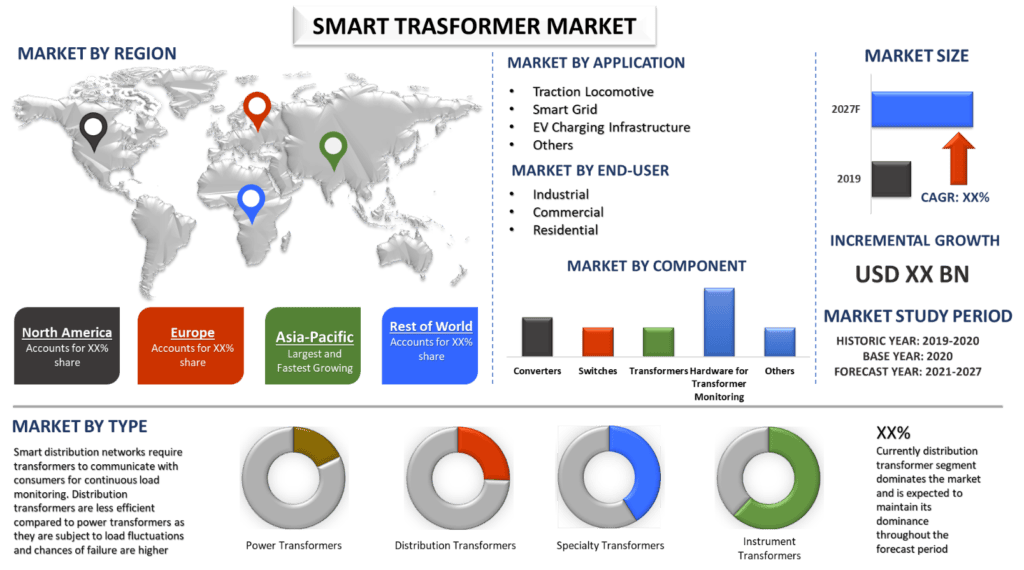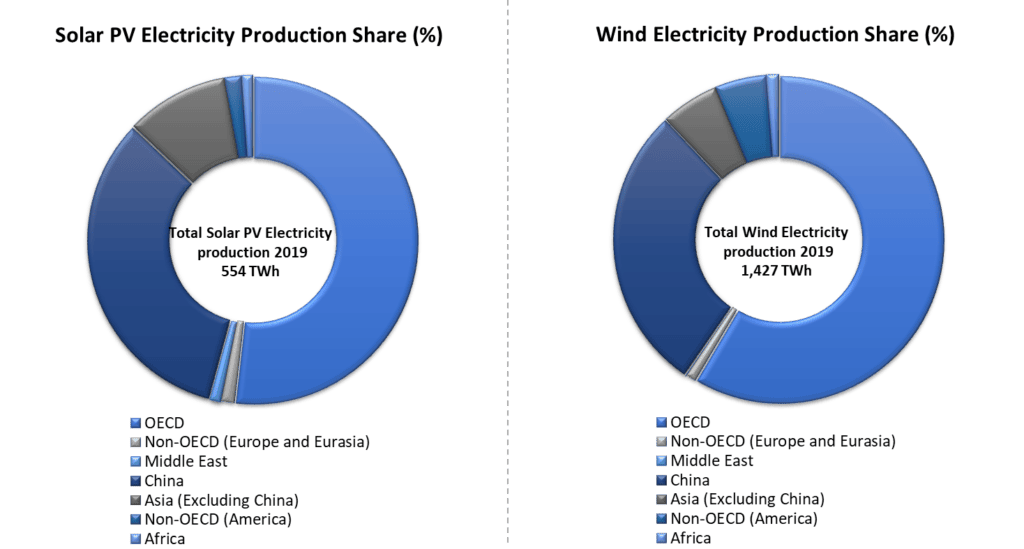- Home
- About Us
- Industry
- Services
- Reading
- Contact Us
Smart Transformers Market: Current Analysis and Forecast (2021-2027)
Emphasis on Type (Power Transformers, Distribution Transformers, Specialty Transformers, Instrument Transformers); Component (Converters, Switches, Transformers, Hardware for Transformer Monitoring, Others); Applications Traction Locomotive, Smart Grid, EV Charging Infrastructure, Others), End-User (Industrial, Commercial, Residential); and Region and Country

Smart Transformers Market was valued at ~US$ 2 billion in 2020 and is expected to grow at a CAGR of ~13% over the forecast period (2021-2027). Smart Transformer, as an integral part of Smart Grid solutions works independently to frequently regulate voltage and maintain contact with Smart Grid and allow remote administration and to provide information and feedback about the power supply and the transformers itself. Smart transformer acts as a power regulator which provide the exact amount of power needed and responds instantly to fluctuations within the power grid. Furthermore, smart transformers include multiple intelligent electronic devices or control systems, which can assess the condition of the transformer and make intelligent recommendations based on design and component data. Major benefits of smart transformer include 75% lower core energy loss, compared to the conventional transformers, smart transformer delivers greater consumptions savings, contributes towards CSR by reducing CO2 emissions, remote monitoring allows for greater visibility of transformers operations, Reduce operating costs. These transformers have an expected lifespan of up to 50 years and more. Online remote monitoring capabilities also act as the one of the major benefits of a smart transformer. Using Internet of Things (IoT) enabled technology, these transformers can allow 24/7 visibility of asset data to better understand how transformer is performing and identify where further efficiencies can be made
Regional share of solar PV and Wind electricity production, 2019

During the Covid-19 pandemic in the early 2020, majority of the countries and region witnessed a country wide lockdown. This has impacted the overall demand for electricity. Global a decline of almost 10% in the overall demand of electricity was witnessed in 2020. Majority of decline was witnessed in the industrial sector, where countries had imposed shut down of manufacturing facilities to reduce the spread of Covid-19. However, demand for electricity is expected to come to normal post 2020.
Insights Presented in the Report
“Amongst Type, Distribution Transformers segment dominated the market in 2020.”
Based on type the global Smart Transformers market is bifurcated into Power Transformers, Distribution Transformers, Specialty Transformers, Instrument Transformers. Currently distribution transformer segment dominates the market and is expected to maintain its dominance throughout the forecast period. High share of the segment can be credited to increased governments initiative to transform the energy sector.
“Amongst Component, Hardware for Transformer Monitoring segment dominated the market in 2020.”
Based on Component, the market is bifurcated into Converters, Switches, Transformers, Hardware for Transformer Monitoring, Others. Currently, Hardware for Transformer Monitoring segment dominates the market and is expected to maintain its dominance throughout the forecast period. ABB provides modular approach to transformer monitoring. ABB transformer electronic control (TEC) acts as the central IED unit of the transformer, i.e., as the communication hub for all other IEDs.
“Amongst Application, Smart Grid segment dominates the market in 2020.”
Based on application, the market is bifurcated into Traction Locomotive, Smart Grid, EV Charging Infrastructure, Others. Currently, Smart Grid segment dominates the market, and is expected to maintain its dominance throughout the forecast period. For instance, as per IEA, despite a 7% year-on-year reduction in overall expenditures, grids became further decentralized and digitalized in 2019. Utilities around the world deployed more sophisticated technologies, including artificial intelligence and digital twinning.
“Amongst End-users, Electricity Transmission & Distribution Poles segment dominated the market in 2020.”
Based on end-users the market is segmented into Industrial, Commercial, and residential. Owing to growing industrial sector paired with growing demand for electricity due to rising urban population is expected to drive the market for smart transformer globally.
“Asia-Pacific represents as the largest markets in the Global Smart Transformers Market.”
For a better understanding of the market adoption, report provide detailed analysis for major region and countries including North America (US, Canada, Rest of North America), Europe (Germany, UK, France, Spain, Rest of Europe), Asia-Pacific (China, Japan, India, Australia, Rest of APAC), and Rest of World. Asia Pacific with countries such as India, China, Japan, and Singapore are investing in clean energy on a large scale to meet its growing energy needs in an efficient way. This would provide ample growth opportunity for the utility sector in the Asia-Pacific region. Some of the major companies profiled in the report includes Siemens AG, General Electric, ABB Limited, Schneider Electric, Wilson Transformer, Mitsubishi Electric, BHEL, Eaton Corp, Alstom, SPX Transformer.
Reasons to buy this report:
- The study includes market sizing and forecasting analysis validated by authenticated key industry experts
- The report presents a quick review of overall industry performance at one glance
- The report covers in-depth analysis of prominent industry peers with a primary focus on key business financials, product portfolio, expansion strategies, and recent developments
- Detailed examination of drivers, restraints, key trends, and opportunities prevailing in the industry
- The study comprehensively covers the market across different segments
- Deep dive country level analysis of the industry
Customization Options:
The Global Smart Transformers Market can further be customized as per the requirement or any other market segment. Besides this, UMI understands that you may have your own business needs, hence feel free to connect with us to get a report that completely suits your requirements.
Table of Content
Analyzing the historical market, estimation of the current market, and forecasting the future of the Global Concentrating Solar Power were the three major steps undertaken to create and analyze the adoption of Concentrating Solar Power across various segments in North America, Europe, Asia Pacific, & Rest of the world. Exhaustive secondary research was conducted to collect the historical market numbers and estimate the current market size. Secondly, to validate these insights, numerous findings and assumptions were taken into consideration. Moreover, exhaustive primary interviews were also conducted, with industry experts across the value chain of the Concentrating Solar Power sector. Post assumption and validation of market numbers through primary interviews, we employed a bottom-up approach to forecast the complete market size. Thereafter, market breakdown and data triangulation methods were adopted to estimate and analyze the market size of segments and sub-segments the industry pertains to. Detailed methodology is explained below:
Analysis of Historical Market Size
Step 1: In-Depth Study of Secondary Sources:
Detailed secondary study was conducted to obtain the historical market size of the Concentrating Solar Power through company internal sources such as annual report & financial statements, performance presentations, press releases, etc., and external sources including journals, news & articles, government publications, competitor publications, sector reports, third-party database, and other credible publications.
Step 2: Market Segmentation:
After obtaining the historical market size of the Concentrating Solar Power Market, we conducted a detailed secondary analysis to gather historical market insights and share for different segments & sub-segments for major regions. Major segments included in the report are as technology, operation type, capacity, and end user. Further regional & country-level analyses were conducted to evaluate the overall adoption of the Concentrating Solar Power in the global context.
Step 3: Factor Analysis:
After acquiring the historical market size of different segments and sub-segments, we conducted a detailed factor analysis to estimate the current market size of Concentrating Solar Power. Further, we conducted factor analysis using dependent and independent variables like rise in carbon emissions and the need for renewable energies like Concentrating Solar Power. Historical trends and their year-on-year impact on the market size and share in the recent past was analyzed. Demand and supply side scenario was also thoroughly studied.
Current Market Size Estimate & Forecast
Current Market Sizing: Based on actionable insights from the above 3 steps, we arrived at the current market size, key players in the Global Concentrating Solar Power Market, and market shares of the segments. All the required percentage split, and market breakdowns were determined using the above-mentioned secondary approach and were verified through primary interviews.
Estimation & Forecasting: For market estimation and forecast, weights were assigned to different factors including drivers & trends, restraints, and opportunities available for the stakeholders. After analyzing these factors, relevant forecasting techniques i.e., bottom-up approach was applied to arrive at the market forecast to 2027 for different segments and subsegments across the major regions globally. The research methodology adopted to estimate the market size encompasses:
- The industry’s market size, in terms of value (US$) and the adoption rate of Concentrating Solar Power across the major markets
- All percentage shares, splits, and breakdowns of market segments and sub-segments
- Key players in the Concentrating Solar Power Market in terms of services offered. Also, the growth strategies adopted by these players to compete in the fast-growing market.
Market Size and Share Validation
Primary Research: In-depth interviews were conducted with the Key Opinion Leaders (KOLs) including Top Level Executives (CXO/VPs, Sales Head, Marketing Head, Operational Head, and Regional Head, Country Head, etc.) across major countries. Primary research findings were then summarized, and statistical analysis was performed to prove the stated hypothesis. Inputs from primary research were consolidated with secondary findings, hence turning information into actionable insights.
Split of Primary Participants in Different Regions

Market Engineering
Data triangulation technique was employed to complete the overall market estimation and to arrive at precise statistical numbers of each segment and sub-segment of the Global Concentrating Solar Power Market. Data was split into several segments & sub-segments post studying various parameters and trends in the areas of technology, operation type, capacity, and end user verticals.
The main objective of the Concentrating Solar Power Market Study
The current & future market trends of Concentrating Solar Power were pinpointed in the study. Investors can gain strategic insights to base their discretion for investments from the qualitative and quantitative analysis performed in the study. Current and future market trends determine the overall attractiveness of the market at a global & country level, providing a platform for the industrial participant to exploit the untapped market to benefit as a first-mover advantage. Other quantitative goals of the studies include:
- Analyze the current and forecast market size of Concentrating Solar Power in terms of value (US$). Also, analyze the current and forecast market size of different segments and sub-segments
- Segments in the study include areas of technology, operation type, capacity, and end user verticals
- Defined analysis of the regulatory framework for the Global Concentrating Solar Power industry
- Analyze the value chain involved with the presence of various intermediaries, along with analyzing customer and competitor behaviors of the industry
- Analyze the current and forecast market size of the Concentrating Solar Power for the major regions & countries
- Major regions studied in the report include North America, Europe, Asia Pacific, and Rest of World
- Company profiles of the Concentrating Solar Power Market players and the growth strategies adopted by them to sustain in the fast-growing market
Deep dive regional & country level analysis of the industry
Related Reports
Customers who bought this item also bought










